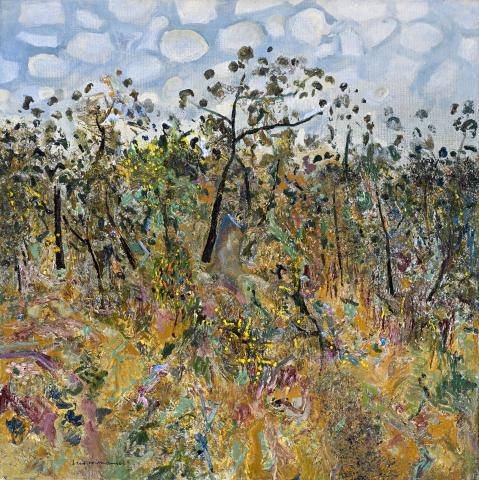ACACIA LANDSCAPE WITH CLOUDS, 1980
FRED WILLIAMS
oil on canvas
101.5 x 101.5 cm
signed lower left: Fred Williams
Rudy Komon Gallery, Sydney (label attached verso)
Private collection
Christie’s, Melbourne, 24 November, 1993, lot 181
Private collection, Hong Kong
Fred Williams’ Acacia Landscape with Clouds, 1980 captures all the bounteous richness of spring with painterly abundance and luxuriance. The vitality of the tangled undergrowth reaching up through the black-trunked trees to the sky, expresses the primal urge of this season of regeneration in all its wonderment. Even the heavens join in. Here, a multitude of puffy white clouds fill the previous cool and empty skies of other paintings. Their patchwork of blues and whites maintain that characteristic emphasis on the picture plane within the overall interplay with illusions of depth. Typically, the painting is square, providing a compositional fence with which to surround and define the piece of landscape chosen. Invention and the very real sense of presence in this and other paintings came from Williams’ constant dialogue with the landscape. The earlier more minimal and refined had long given way to a delight in encompassing ‘an explicit feeling for a particular place or motif’.1
Golden wattle, as the harbinger of spring, caught Williams’ eye early, especially the way in which its brilliant yellows pierced the dark of winter. His first painting encounter with winter-flowering wattles was in July of 1969, when he visited Clifton Pugh’s property at Dunmoochin, north-east of Melbourne. In his diary for 24 July 1969, Williams wrote of his fascination with painting wattles, and a little later: ‘I would really like to work from them as they mature’.2 A widening of his palette, with its new rainbow expanse, allowed for the easier inclusion of yellow, now a feature of a number of paintings in which acacias were presented. Fine examples from the 1974 series include Acacia Saplings (Deutscher and Hackett, 13 September 2016, lot 16), and Acacias I and II (private collection), and from the numerous 1975 wattle paintings, as seen in the very colourful Botanist’s Garden of 1975 (private collection). There were other gems, such as Wattles at Dunmoonchin, 1977, of floating forms and luminous atmosphere.
Acacia Landscape with Clouds was painted in 1980, a triumphal one for Williams. Awarded a doctorate of law by Monash University, he held solo exhibitions in Paris at the Australian Embassy, at Fischer Fine Art, London, and the National Gallery of Victoria, Melbourne. A prestigious volume of his art, written by Patrick McCaughey, was published by Bay Books, Sydney. Writing in The Bulletin some years before, the artist-art critic, Nancy Borlase said of Williams paintings: ‘His swirls of crusty paint, his subtly veiled space illusions, his puffs and spills of pigment that so lightly glide down the canvas are, like the late Monet’s, as much abstract as representational – this is the stuff and substance of his art’.3
1. McCaughey, P, ‘Fred Williams 1969-79’, exhibition catalogue, Fischer Fine Art, London, 1980
2. Williams, F., quoted in Mollison, J., A Singular Vision: The Art of Fred Williams, Australian National Gallery, Canberra, 1989, p. 174
3. Borlase, N., ‘A painter at his peak pushes further on’, The Bulletin, 26 April 1975, p. 51
DAVID THOMAS
